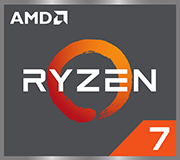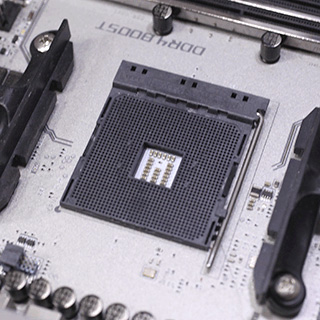8
Cores
16
Threads
65 W
TDP
3.8 GHz
Frequency
4.6 GHz
Boost
Cezanne
Codename
Socket AM4
Socket
The AMD Ryzen 7 5700G is a desktop processor with 8 cores, launched in April 2021. It is part of the Ryzen 7 lineup, using the Zen 3 (Cezanne) architecture with Socket AM4. Thanks to AMD Simultaneous Multithreading (SMT) the core-count is effectively doubled, to 16 threads. Ryzen 7 5700G has 16 MB of L3 cache and operates at 3.8 GHz by default, but can boost up to 4.6 GHz, depending on the workload. AMD is making the Ryzen 7 5700G on a 7 nm production node using 10,700 million transistors. The silicon die of the chip is not fabricated at AMD, but at the foundry of TSMC. You may freely adjust the unlocked multiplier on Ryzen 7 5700G, which simplifies overclocking greatly, as you can easily dial in any overclocking frequency.
With a TDP of 65 W, the Ryzen 7 5700G consumes typical power levels for a modern PC. AMD's processor supports DDR4 memory with a dual-channel interface. The highest officially supported memory speed is 3200 MT/s, but with overclocking (and the right memory modules) you can go even higher. For communication with other components in the computer, Ryzen 7 5700G uses a PCI-Express Gen 3 connection. This processor features the Radeon Vega 8 integrated graphics solution.
Hardware virtualization is available on the Ryzen 7 5700G, which greatly improves virtual machine performance. Programs using Advanced Vector Extensions (AVX) can run on this processor, boosting performance for calculation-heavy applications. Besides AVX, AMD is including the newer AVX2 standard, too, but not AVX-512.
With a TDP of 65 W, the Ryzen 7 5700G consumes typical power levels for a modern PC. AMD's processor supports DDR4 memory with a dual-channel interface. The highest officially supported memory speed is 3200 MT/s, but with overclocking (and the right memory modules) you can go even higher. For communication with other components in the computer, Ryzen 7 5700G uses a PCI-Express Gen 3 connection. This processor features the Radeon Vega 8 integrated graphics solution.
Hardware virtualization is available on the Ryzen 7 5700G, which greatly improves virtual machine performance. Programs using Advanced Vector Extensions (AVX) can run on this processor, boosting performance for calculation-heavy applications. Besides AVX, AMD is including the newer AVX2 standard, too, but not AVX-512.
Physical
| Socket: | AMD Socket AM4 |
|---|---|
| Foundry: | TSMC |
| Process Size: | 7 nm |
| Transistors: | 10,700 million |
| Die Size: | 180 mm² |
| Package: | µOPGA-1331 |
| tCaseMax: | 95°C |
Processor
| Market: | Desktop |
|---|---|
| Production Status: | Active |
| Release Date: | Apr 13th, 2021 |
| Part#: | 100-000000263 |
Performance
| Frequency: | 3.8 GHz |
|---|---|
| Turbo Clock: | up to 4.6 GHz |
| Base Clock: | 100 MHz |
| Multiplier: | 38.0x |
| Multiplier Unlocked: | Yes |
| TDP: | 65 W |
Architecture
| Codename: | Cezanne |
|---|---|
| Generation: |
Ryzen 7
(Zen 3 (Cezanne)) |
| Memory Support: | DDR4 |
| Rated Speed: | 3200 MT/s |
| Memory Bus: | Dual-channel |
| ECC Memory: | No |
| PCI-Express: |
Gen 3, 16 Lanes (CPU only) |
Core Config
| # of Cores: | 8 |
|---|---|
| # of Threads: | 16 |
| SMP # CPUs: | 1 |
| Integrated Graphics: | Radeon Vega 8 |
Cache
| Cache L1: | 64 KB (per core) |
|---|---|
| Cache L2: | 512 KB (per core) |
| Cache L3: | 16 MB |
Features
|
Nov 15th, 2024 06:20 EST
change timezone
Latest GPU Drivers
New Forum Posts
- Can you split pcie lanes for one device (for example pcie 2.0 x1 to pcie 1.0 x2) (18)
- Problems with Gainward GTX 570 Phantom (4)
- TPU's Nostalgic Hardware Club (19409)
- [Test Build] Fix for Driver Signing on Windows 11 24H2 (32)
- FlashMyBoard - Automated BIOS Update Tracking & Notification System (2)
- Popping / crackling sound at the start of some audio playback (16)
- Post your cooling. (124)
- 3D Printer Club (289)
- 9800x 3d vs 12900k - Battle of the Century (70)
- The sands of time have run out, Son of Durotan. (Warcraft III Fan Club/Memories Thread) (14)
Popular Reviews
- NVIDIA App v1.0 Review
- AMD Ryzen 7 9800X3D Review - The Best Gaming Processor
- Beelink GTi12 Ultra Mini-PC + EX Dock (Intel Core i9-12900H) Review
- Glorious Series 2 Pro Wireless Review
- XPG Invader X Mini Review
- Upcoming Hardware Launches 2024 (Updated Nov 2024)
- Epomaker TH40 Wireless Mechanical Keyboard Review
- Team Group A440 Lite 2 TB Review
- MIRPH-1 Open-Back Dynamic Driver Headphones Review
- DDR5 Memory Performance Scaling with AMD Zen 5
Controversial News Posts
- AMD Falling Behind: Radeon dGPUs Absent from Steam's Top 20 (222)
- AMD Ryzen 7 9800X3D Stocks Vaporized in Retail, Being Scalped (151)
- AMD Introduces Next-Generation AMD Ryzen 7 9800X3D Processor, $479, Nov 7 (124)
- Apple and Samsung in the Fray to Acquire Intel: Rumor (123)
- AMD Ryzen 7 9800X3D Comes with 120W TDP, 5.20 GHz Boost, All Specs Leaked (120)
- Microsoft Offers $30 Windows 10 Security Extension for Home Users (118)
- AMD Ryzen 7 9800X3D Has the CCD on Top of the 3D V-cache Die, Not Under it (110)
- Afraid of Spiders? Call of Duty: Black Ops 6's Accessibility Features Have You Covered (103)








